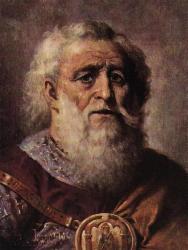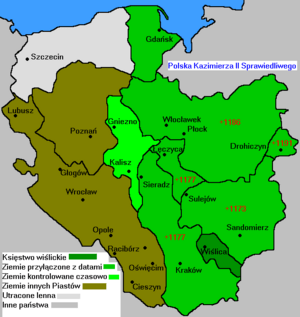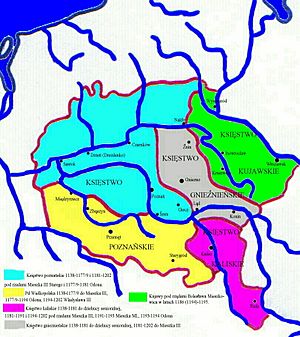Mieszko III the Old facts for kids
Quick facts for kids Mieszko III the Old |
|
|---|---|
 |
|
| High Duke of Poland | |
| Tenure | 1173–1177 1191 1198–1199 1201 |
| Duke of Greater Poland | |
| Tenure | 1138–1177 1182–1202 |
| Born | c. 1126/1127 |
| Died | 13 March 1202 (aged 75) Kalisz |
| Burial | Cathedral of Saint Paul the Apostle, Kalisz |
| Spouse | Elisabeth of Hungary Eudoxia of Kiev |
| Issue more... |
Odon of Poznań Stephen of Greater Poland Elisabeth< Wierzchoslawa Ludmilla Bolesław of Kuyavia Mieszko the Younger Władysław III Spindleshanks Anastasia |
| House | Piast dynasty |
| Father | Bolesław III Wrymouth |
| Mother | Salomea of Berg |
| Religion | Roman Catholic |
Mieszko III the Old (born around 1126 or 1127 – died March 13, 1202) was an important ruler from the Piast dynasty in Poland. He was the Duke of Greater Poland starting in 1138. He also became the High Duke of Poland several times, ruling from 1173 until his death.
Mieszko was the son of Duke Bolesław III Wrymouth of Poland. His mother was Salomea, who was the daughter of a German count.
Contents
- Mieszko's Early Life and Family
- First Fights with Władysław II
- More Conflicts and Władysław's Exile
- Gaining Recognition and Alliances
- Emperor Frederick Barbarossa's Campaign
- Changes in Sandomierz and a Rebellion
- Family Disputes in Silesia
- Mieszko Becomes High Duke of Poland
- Exile and Return to Greater Poland
- Brief Return to Power
- Final Agreement and Death
- Marriages and Issue
- See also
- Sources
Mieszko's Early Life and Family
When Mieszko's father, Bolesław III, died in 1138, he left a special plan for how Poland should be ruled. This plan, called the Testament of Bolesław III, divided Poland among his sons.
Mieszko received the new Duchy of Greater Poland. His main home was in Poznań. His older half-brother, Władysław II the Exile, became the High Duke. This meant Władysław was the main ruler of Poland, based in Kraków.
First Fights with Władysław II
Sharing the Łęczyca Land
Mieszko and his younger brother, Bolesław IV the Curly, had their first big disagreement with High Duke Władysław II in 1140–1141. Their mother, Salomea, had control of the Łęczyca land for her lifetime. After she died, this land was supposed to go to Władysław.
However, Salomea and her sons decided to divide Łęczyca among themselves. They did this without Władysław's knowledge.
Seeking Allies Against the High Duke
In 1141, Salomea held a meeting. She and her sons planned to marry their younger sister, Agnes, to a son of the Grand Prince of Kiev. They hoped this would give them an ally against Władysław.
But Władysław acted quickly. The Grand Prince of Kiev chose to ally with the strong High Duke instead. Władysław's son, Bolesław, got engaged to the Grand Prince's daughter.
Władysław was angry that he wasn't invited to the meeting. He supported Kiev's military actions against his mother and brothers. This first conflict was a clear win for Władysław.
More Conflicts and Władysław's Exile
The Łęczyca Land Dispute Continues
In 1144, Salomea died. High Duke Władysław II took control of the Łęczyca Land, as his father's will intended. But Bolesław IV and Mieszko III disagreed. They wanted the land to go to their younger brother, Henry.
Fighting broke out in 1145. Władysław won, thanks to his allies from Kiev. He kept control of Łęczyca.
The Fall of Piotr Włostowic
Władysław wanted to unite all of Poland under his rule. This upset many powerful people, including his trusted adviser, Piotr Włostowic. Piotr supported the younger dukes.
Władysław's wife, Agnes, convinced him to get rid of Piotr. Piotr was captured, blinded, and forced to leave the country. This cruel act angered many of Piotr's supporters. Piotr went to Kiev and started working against Władysław. This was the beginning of Władysław's downfall.
Władysław Forced to Leave Poland
War started again in 1146. This time, Władysław's allies from Kiev were busy with their own problems. Władysław had to ask for help from the German King Conrad III.
At first, Władysław seemed to be winning. Bolesław IV and Mieszko III fled to Poznań. But then, Władysław lost support. The Archbishop of Gniezno removed him from the church because of his actions against Piotr Włostowic. Many of Władysław's own people rebelled against his harsh rule.
By May 1146, Władysław was completely defeated. He and his family had to flee Poland. They went to Germany, seeking protection from King Conrad III.
New Rulers in Poland
After Władysław left, Bolesław IV and Mieszko III took control. Bolesław, as the older brother, became the new High Duke. Mieszko kept his Duchy of Greater Poland. Their younger brother, Henry, finally received his Duchy of Sandomierz. Only the youngest brother, Casimir II the Just, was left without land.
King Conrad III of Germany tried to help Władysław get his throne back. Eventually, an agreement was made. Bolesław IV would rule, but he had to pay a tribute to the German king. The conflict between Władysław and his brothers was not fully solved yet.
Gaining Recognition and Alliances
Support from the Pope
The younger dukes wanted to make their power stronger. In 1147, Pope Eugene III officially recognized their right to rule. This was a big step for them.
Crusade and German Alliances
In 1147, Mieszko III joined a Wendish Crusade. This was a war against pagan Slavic tribes. Mieszko also tried to protect Polish interests in these lands. This angered some German leaders.
To improve relations, Mieszko made an agreement with Albert the Bear, a German count. This was sealed by the marriage of Mieszko's sister, Judith, to Albert's son, Otto.
Emperor Frederick Barbarossa's Campaign
Paying Homage to the Emperor
In 1152, Bolesław IV was supposed to meet the new German King, Frederick Barbarossa, and show him respect. But Bolesław didn't go. Frederick was busy with other matters, but the Polish issue came up again.
Poland Under Attack
In 1157, Emperor Frederick Barbarossa launched a campaign against Poland. Bolesław IV and Mieszko III did not defend the border. Instead, they burned their castles and retreated. Finally, Bolesław's forces surrendered to the Emperor near Poznań.
After this defeat, the Polish dukes had to apologize to the Emperor. They also had to pay a large tribute. They promised to send food for the Emperor's army and return the Silesia Province. As a guarantee, their younger brother, Casimir II, was sent to Germany as a hostage.
Frederick Barbarossa thought the problem was solved. But Bolesław IV did not keep his promises.
Silesia Returned to Władysław's Sons
In 1159, Władysław II died in exile. He never returned to Poland. It took more pressure from the Emperor for Władysław's sons to finally get their lands back. In 1163, Bolesław IV and Mieszko III returned Silesia to their nephews. This made Silesia the homeland of the Silesian Piasts.
Changes in Sandomierz and a Rebellion
Henry of Sandomierz Dies
In 1166, Mieszko III and his brothers went on another crusade. Duke Henry of Sandomierz was killed in battle. Before he left, Henry had said that his duchy should go to his youngest brother, Casimir II the Just. Casimir was the only brother who didn't have his own land.
However, High Duke Bolesław IV ignored Henry's will. He took Sandomierz for himself.
Casimir II's Rebellion
This decision made Casimir II very angry. He started a rebellion. Mieszko III supported him, along with other important people. In 1168, the rebels met and chose Mieszko III as the new High Duke. They also gave Sandomierz to Casimir II.
But Bolesław IV avoided a full defeat. He agreed to the rebels' demands. Henry's duchy was divided into three parts: Casimir got Wiślica, Bolesław kept Sandomierz, and Mieszko got the rest.
Family Disputes in Silesia
In 1172, a new conflict arose among the Silesian dukes. Duke Bolesław the Tall wanted his younger son, Henry, to inherit everything. He ignored the claims of his older son, Jarosław. Jarosław had been forced to become a priest, but he wanted his share of the lands.
Mieszko III supported Jarosław. This started a civil war. To prevent the Emperor from getting involved again, High Duke Bolesław IV sent Mieszko III to Germany with a large sum of money.
In 1173, an agreement was reached. Bolesław the Tall kept Wrocław. But he had to give the Duchy of Opole to his son Jarosław for life. He also had to share the rest of Silesia with his younger brother, Mieszko IV Tanglefoot.
Mieszko Becomes High Duke of Poland
When his brother Bolesław IV died in 1173, Mieszko III became the new High Duke of Poland. He was the oldest surviving member of the royal family.
Mieszko wanted to keep all the power for himself. He stayed in Greater Poland, and appointed a governor to rule Lesser Poland. He also introduced strict taxes, which made the nobles in Lesser Poland unhappy.
Mieszko had success in foreign policy. His daughter Elisabeth married the Duke of Bohemia. Another daughter, Anastasia, married Duke Bogislaw I of Pomerania. These marriages helped Poland keep control over the Duchy of Pomerania.
Rebellion Against Mieszko
In 1177, Mieszko III's oldest son, Odon of Poznań, rebelled against his father. Odon was worried about his inheritance. He was supported by Bishop Gedko of Kraków, his cousin Bolesław the Tall, and his uncle Casimir II the Just.
Odon's main reason for rebelling was that Mieszko seemed to favor his sons from his second marriage. Mieszko also tried to force Odon to become a priest, which would remove him from the line of succession. The other rebels were unhappy with Mieszko's strict rule.
The rebellion surprised Mieszko. He thought his family was loyal.
Mieszko Loses Power
At first, Mieszko kept control of Greater Poland. But Casimir II the Just, who led the rebellion, made a deal with his allies. Silesia was given to Bolesław the Tall, and Greater Poland was given to Odon.
When Mieszko Tanglefoot and Jarosław of Opole heard about this, they sided with Mieszko III. They rebelled against Bolesław the Tall. This meant Bolesław was too busy fighting his own family to take Kraków.
Instead, Casimir II the Just took control of Kraków. He was declared the new High Duke of Poland. Mieszko III had no choice but to flee. He went to his nephew Mieszko Tanglefoot for protection. Soon after, Mieszko III left Poland to seek help from other countries. Odon took control of all Greater Poland.
Exile and Return to Greater Poland
By 1179, Mieszko went to Bohemia, ruled by his son-in-law. But he didn't get help there. Then he turned to Germany and Emperor Frederick Barbarossa. The Emperor offered help if Mieszko paid a huge sum of silver, which Mieszko couldn't afford.
Finally, Mieszko's other son-in-law, Duke Bogislaw I of Pomerania, agreed to help him. With the help of his Pomeranian allies, Mieszko connected with his supporters in Poland. In 1181, he was able to take back the eastern parts of Greater Poland, including Gniezno and Kalisz. Soon after, he also recovered western Greater Poland. Odon was pushed to the southern lands. In 1182, Mieszko and Odon officially made peace. High Duke Casimir II the Just did nothing during these events, which allowed Mieszko to regain all of Greater Poland.
Trying to Regain All of Poland
Mieszko still wanted to rule all of Poland. In 1184, he tried to make an alliance with the German King Henry VI, offering him a lot of silver. But Casimir II the Just found out and sent Henry even more money than Mieszko.
After failing with the German king, Mieszko decided to take control of Masovia and Kuyavia. These lands were ruled by his nephew, Leszek, who was the only surviving son of Bolesław IV. Mieszko convinced Leszek to name him as his successor if Leszek died without children.
However, in 1185, Leszek changed his will. He named his younger uncle, High Duke Casimir II the Just, as his successor. This might have been because Mieszko was too harsh. But when Leszek died in 1186, Mieszko acted quickly. He took the Kuyavia region and added it to his duchy. He then gave this land to his son, Bolesław of Kuyavia.
Brief Return to Power
In 1191, some nobles in Lesser Poland were unhappy with High Duke Casimir II the Just. With their help, Mieszko was finally able to take Kraków and become High Duke again. He put one of his sons in charge of Kraków.
However, Casimir quickly regained Kraków. Mieszko's son was captured but soon released. After this failed attempt, Mieszko gave the Kalisz region in Greater Poland to his son, Mieszko the Younger, as his own duchy.
Losses and New Divisions
In 1193, Mieszko the Younger died. His Duchy of Kalisz returned to Mieszko III. Eight months later, in 1194, Mieszko's older son Odon also died. These two deaths forced Mieszko to make new plans. He kept Kalisz for himself. Southern Greater Poland was given to his youngest son, Władysław III Spindleshanks. Władysław also became the guardian of Odon's young son.
High Duke Casimir II the Just died in 1194. Mieszko again tried to take control of Lesser Poland. But this time, the local nobles preferred Casimir's young sons, Leszek the White and Konrad. Mieszko's attempts to regain power led to a bloody battle in 1195, where Mieszko himself was badly injured, and his son Bolesław of Kuyavia died. After the battle, Mieszko retreated without waiting for his allies.
Final Agreement and Death
The Battle of Mozgawa showed Mieszko that taking the throne by force was very difficult. So, he started talking with Casimir's widow. In 1198, he was finally allowed to return to Lesser Poland. But he had to give up Kuyavia to Casimir's sons.
In 1199, Mieszko was removed from power again, and Leszek the White was restored as High Duke. However, three years later, a new agreement was made, and Mieszko was able to return. He kept the title of High Duke but had to give up some of his powers.
Mieszko III the Old died shortly after this, in 1202. He had outlived all his brothers and all his sons except for Władysław III Spindleshanks, who became the next High Duke of Poland and Duke of Greater Poland.
Marriages and Issue
Mieszko III had two marriages and many children.
First Marriage
Around 1136, Mieszko married Elisabeth. She was the daughter of King Béla II of Hungary. They had:
- Odon (born around 1149 – died April 20, 1194)
- Stephen (born around 1150 – died between 1166 and 1177)
- Elisabeth (born 1152 – died April 2, 1209). She married Duke Soběslav II of Bohemia and later Conrad II of Landsberg.
- Wierzchoslawa Ludmilla (born before 1153 – died before 1223). She married Frederick of Bitsch, who later became Duke of Lorraine.
- Judith (born before 1154 – died after December 12, 1201). She married Bernhard of Anhalt, who later became Duke of Saxony.
Second Marriage
Around 1154, Mieszko married Eudoxia of Kiev. She might have been the daughter of Grand Prince Iziaslav II of Kiev. They had:
- Bolesław (born 1159 – killed in battle on September 13, 1195)
- Mieszko the Younger (born around 1160–1165 – died August 2, 1193)
- Władysław III Spindleshanks (born around 1161–1167 – died November 3, 1231)
- Salomea (born around 1162–1164 – died May 11, around 1183). She married Prince Ratibor (II) of Pomerania.
- Anastasia (born around 1164 – died after May 31, 1240). She married Duke Bogislaw I of Pomerania.
See also
 In Spanish: Miecislao III el Viejo para niños
In Spanish: Miecislao III el Viejo para niños
Sources
|
Mieszko III the Old
Born: ca. 1127 Died: 13 March 1202 |
||
| New title | Duke of Greater Poland 1138–1177 |
Succeeded by Odon |
| Preceded by Bolesław IV the Curly |
High Duke of Poland 1173–1177 |
Succeeded by Casimir II the Just |
| Preceded by Casimir II the Just |
Duke of Kalisz 1182–1191 |
Succeeded by Mieszko the Younger |
| Preceded by Odon |
Duke of Greater Poland 1182–1202 |
Succeeded by Władysław III Spindleshanks |
| Duke of Poznań 1182–1202 |
||
| Preceded by Casimir II the Just |
Duke of Gniezno 1182–1202 |
|
| High Duke of Poland 1191 |
Succeeded by Casimir II the Just |
|
| Preceded by Odon |
Duke of Kalisz 1194–1202 |
Succeeded by Władysław III Spindleshanks |
| Preceded by Bolesław |
Duke of Kuyavia 1195–1198 |
Succeeded by Leszek the White |
| Preceded by Leszek the White |
High Duke of Poland 1198–1199 |
Succeeded by Leszek the White |
| High Duke of Poland 1202 |
Succeeded by Władysław III Spindleshanks |
|




